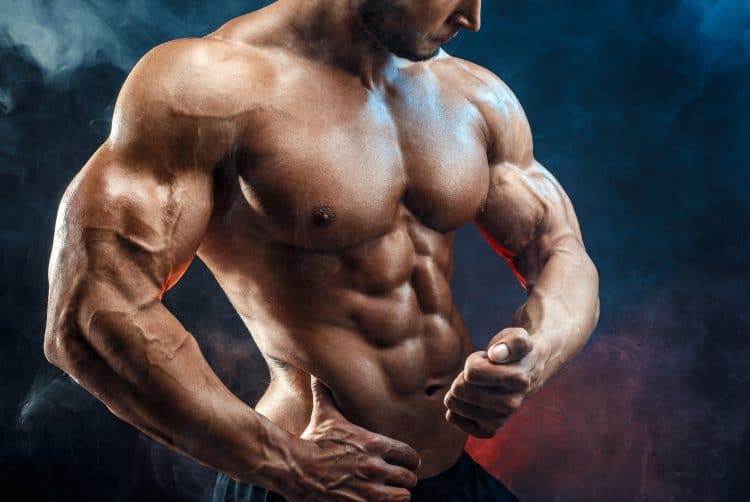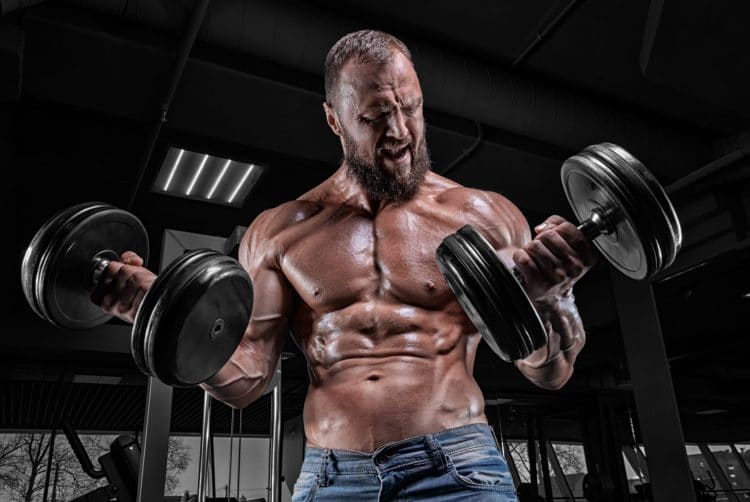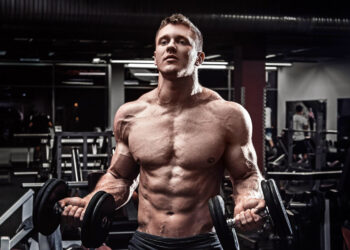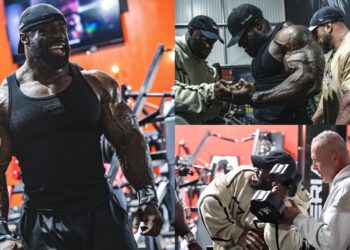If you’re taking precision measurements of your body—to track fat composition and muscle mass—you may notice that one side of your body develops faster than the other.
For some people, it’s noticeable in their right or left pectoral muscles, while others see greater strength and size development in one leg over the other.
Most common, however, is an imbalance between your two arms. In fact, some weight trainees find that one bicep or tricep is up to half an inch larger than the other!
Before you start worrying that you’re doing something wrong or training your body incorrectly, you need to understand the truth about this specific imbalance. Below, we’ll take a look at why having one arm bigger than the other is no cause for concern.
It’s a Perfectly Normal Problem
That’s right: it is absolutely normal for you to have one arm bigger than the other.
Our bodies are naturally asymmetrical—from the way the two halves of our face aren’t quite the same to the slightly different formation of your feet. We simply don’t notice the difference most of the time.
Level Up Your Fitness: Join our 💪 strong community in Fitness Volt Newsletter. Get daily inspiration, expert-backed workouts, nutrition tips, the latest in strength sports, and the support you need to reach your goals. Subscribe for free!
In some cases, imbalances can be the cause or result of musculoskeletal problems. Incorrect formation of the spine can tilt your pelvis, or having one leg noticeably longer than the other can alter the way your ankles, knees, and hips move.
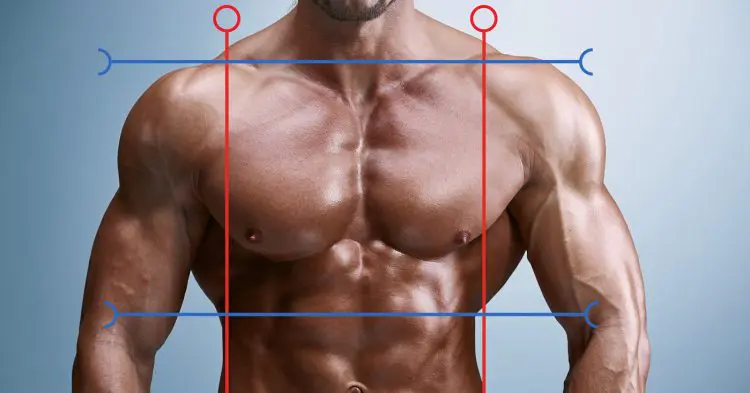
Muscular imbalances, however, typically occur for other reasons:
Imbalanced loads during training
This happens when your body adapts to an extra-heavy load or muscular fatigue by shifting the weight slightly toward your “stronger” side (see an explanation below as to which side is stronger). You’ll notice this when you Curl—the barbell will tilt slightly lower toward the weaker side, because the muscles on that side have a harder time pushing or curling it.
If you don’t correct this problem by paying extra attention to the weaker side, the muscles will continue to develop in equal measure—one side always stronger than the other.
Cheating during training
It’s not uncommon to “cheat” when you’re at the end of that last tough set. Cheat reps are a useful tool to complete a set and push your muscles fully to fatigue. Changing up your technique—by adding a little swing for momentum or shift in posture to shorten the range of motion—can help you crank out a couple more reps.
However, if you allow yourself cheat reps, you may find that your weaker side cheats sooner in the set than your stronger side. One of your shoulders may shift forward while you curl, engaging your lats and delts to complete the difficult movement, or you may add a bit more swing to the curl on your weaker side. Over time, this can lead to muscular imbalance.
Hand dominance
We all have a “dominant” hand, the hand that is used for gross and fine motor tasks like catching or throwing, writing, manipulating forks, spoons, and knives, and so on. Which hand is dominant is defined both by genetics and brain function.
Research has proven that the non-dominant hand is typically weaker in right-handed people, but there are no significant strength differences for left-handed people. If you notice a larger right arm and you are right-handed, it could be the result of your dominant hand developing more strength and precision than your left hand. After all, you instinctively pick up and move objects with your dominant hand because it has greater coordination.
But what if you’re right-handed and your left biceps, triceps, or forearm is bigger? Well, that could still be the result of having a dominant hand. Your right hand is typically utilized for more precise tasks (such as writing, gripping small objects, etc.) so you unconsciously use your left hand for gross motor skills (tasks that involve large muscles in your arms)—for example, carrying a heavy load of groceries from your car.
It’s also possible your brain “knows” which is your weaker and stronger side because of your hand dominance. So, in order to compensate for this imbalance, it “tries harder” to lift with your non-dominant side. Over time, this has led to an increase in muscular size and strength on your non-dominant arm.
Related: Bicep Curl vs. Hammer Curl
Injuries
Yes, injuries can absolutely lead to a muscular imbalance. If you’ve injured any muscles, tendons, ligaments, or bones in one arm, your body has to compensate during the recovery time by utilizing the other arm. For example, right-handed people who break an arm end up having to eat, tie their shoes, dress, and do everything with their left hand.
Even after the injury is healed, it takes time to restore the strength that was lost during recovery. You might not have yet regained full strength in the injured arm, so the muscle has not re-grown to its original size—or it simply hasn’t matched the pace of growth of the uninjured arm.
Tendon and muscle injuries specifically in the arm muscles (especially in the biceps) can actually alter the way the muscle appears when tensed. If you tore a tendon or muscle but didn’t get corrective surgery, it’s possible the connective tissue or muscle heads reattached in the wrong place, giving one muscle a “bunched” look and making it appear smaller than the other.
Genetics
Your genes determine your anatomy and body composition, the way fat is transported to adipose tissues around your body and how muscles are formed as a result of your training. Genetics may be the reason that one arm is bigger than the other—not only does the larger arm get more blood flow from larger blood vessels, but there are more nerves going to that muscle on that side, so the muscle is more stimulated during exercise.
Level Up Your Fitness: Join our 💪 strong community in Fitness Volt Newsletter. Get daily inspiration, expert-backed workouts, nutrition tips, the latest in strength sports, and the support you need to reach your goals. Subscribe for free!
Related: How to Correct Muscle Imbalances
Pay Attention to What Matters: Strength
You may have noticed that one arm is bigger than the other, but the appearance of your muscles is only the second most important thing to pay attention to. What matters is your strength!
Next time you’re performing Dumbbell Biceps Curls or Triceps Kickbacks, pay attention to how easy or difficult it is to complete a full 10-rep set. Focus on one arm at a time, and look for the moment when your muscles start to approach muscular fatigue. You’ll notice that one arm can typically complete the 10-rep set, but the other arm starts to struggle when you hit Rep #7 or #8. This will usually indicate that the two muscles aren’t equal in strength.
All of the above-mentioned reasons for arm size imbalance can also contribute to strength inequalities, too. If you’ve been training for years and just now noticing the difference, it’s likely that you have been “cheating” or your body has been adjusting its balance to correct for the weaker side.
Your goal when correcting the problem should be first and foremost to correct the strength imbalance so both arms have equal power, stamina, and endurance. Do that, and you’ll likely find that it corrects the size and appearance imbalance, too.
How to Train the Problem Away and Restore Proper Balance
The first step is to make 100% certain you actually have an imbalance in both strength and size. Don’t just eyeball your biceps, triceps, or forearms in the mirror—get a body scan or run a tape measure around those guns. Get the exact measurements so you know for sure that there is a size difference between the two.
Perform a set of Dumbbell Biceps Curls or Close Grip Bench Presses using heavy weight (enough that you can barely complete 10 reps). See if one of your arms fatigue faster than the other, or if you struggle sooner on one side than the other. This will confirm that there is a difference in arm strength.
Now that you’re sure there is an actual imbalance, it’s time to start training to correct the problem!
Step #1: Analyze Your Form
Next time you’re curling (with barbell or dumbbell), stand in front of a mirror and pay close attention to your form. Look at your arms, at the way the bar tilts slightly to one side, and any hunching in your shoulders to compensate for muscle fatigue. Focus on totally isolating the muscles and eliminating any swing from the curls.
The same for your next set of Close Grip Bench Presses. See if the bar sways to either the right or left, or if you can visibly see one arm pushing higher or faster than the other.
Correct for these postural imbalances, and you’re well on your way toward getting your weaker arm up to par.
Step #2: Ditch the Barbell
Because you want to focus on each arm individually, it’s time to set the barbell aside and use only dumbbells. This way, your stronger arm won’t be able to compensate for your weaker arm, and both sides will get an equal workout.
Stick with Triceps and Forearms exercises that only work one arm at a time: Kickbacks, Overhead One-Arm Extensions, Wrist Curls, etc.
When working your biceps using Curls (Hammer Curls, Standard Curls, Isolated Curls, Preacher Curls, etc.), focus on completing a set with one arm at a time rather than alternating arms. This will make it easier for you to pay attention to your form for each arm, particularly the weaker arm. Isolate the movement as much as possible to focus on the target muscle alone.
Don’t worry if your weaker, smaller arm has a hard time completing the same number of sets and reps as your dominant arm. You can always drop the weight slightly so your stronger arm can complete the sets more easily, but the weaker arm trains completely to failure. Over time, this will strengthen your weaker arm and bring it up to par with your stronger arm.
Step #3: Increase Volume and Intensity
To correct the strength imbalance, you’ll want to pay extra attention to your weaker arm. You do this by incorporating additional reps or using more weight for that arm only, in every set you do.
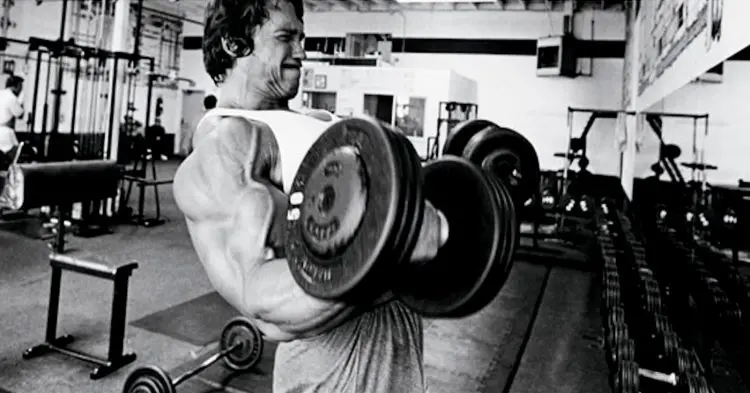
More Weight – Use your “regular” weight for your stronger arm, but train your weaker arm with a dumbbell that is 5-10 pounds heavier. Push your muscles to failure, even if that means performing fewer reps than usual. Keep working with extra weight on the weaker side until it can perform the same number of reps as your stronger arm with the same amount of weight.
Rep + 1 – This is a simple technique that will double the training volume of your weaker arm, accelerating muscle growth and strength gains. Start off by performing a single rep with just the weaker side, then perform a rep with both arms together. Again, perform a single rep with just the weaker arm, followed by a rep with both arms. Your weaker arm will fatigue faster, so you’ll end up doing fewer reps with both arms together. However, it will rapidly increase the strength of your weaker arm, helping it to catch up to the dominant arm.
Set + 1 – This technique is the same concept as the “Rep + 1”, only it involves an entire extra set for your weaker arm. Perform a set with just your weaker arm, rest, then perform a set with both arms. Repeat this pattern until your weaker arm reaches muscle failure. Your stronger arm won’t get as good of a workout, but only for the few weeks it will take to train up the weaker arm to equal strength.
Related articles to maximize your bicep training:
- Reverse Curls Guide – Muscles Worked, How-To, Benefits, Tips And Variations
- How To Do Drag Curls To Overload The Biceps
- WATCH: Bicep Curls Gone Bad – Big Mistakes
- EZ Curl Bar And Preacher Curls Vs Barbell And Dumbbell Curls
- The 13 Best Methods For Increasing Training Intensity
Conclusion
Having one arm bigger and/or stronger than the other is absolutely normal and nothing to be concerned about. However, paying extra attention to the smaller, weaker arm will help to correct muscular imbalances and equalize the strength and size for both arms. Not only will you look better when you flex, but both arms will continue to develop equal power!




